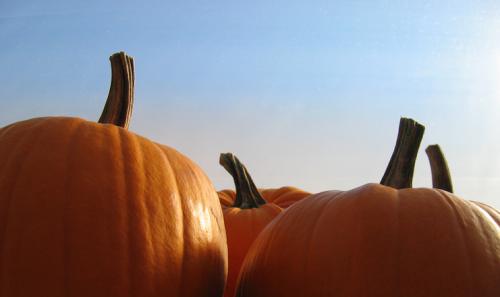Exploring our world: Can you see a pumpkin in the dark?
Discover the excitement of science exploration by exploring light and sight.

Can you see a pumpkin in the dark? Do you need light to see? How much light do you need to see? The Michigan State University Extension science team’s goal is to increase science literacy across Michigan. One way we support an increased interest in science is to provide information and ideas for engaging youth in exploring their world. Adults can help youth increase their science literacy by encouraging them to ask questions and discover answers. Exploring light and sight is just one way to engage youth in STEM (Science, Technology, Engineering and Mathematics).
Ask youth to imagine they are sitting in a room with a pumpkin on the table in front of them and the lights go out. There are no windows or cracks around the door, so no light can enter the room.
- Can they see the pumpkin on the table?
- Can they see it after your eyes have time to adjust?
- Can they see the shape but not the color?
Now help youth test their hypothesis (possible answer to a question). Find a location where all light can be easily blocked; a bathroom might be a good choice. Place a pumpkin in the room. Turn on a flash light then turn out the lights and block any light entering the room. Finally, turn off the flashlight and look at the pumpkin. Allow time for everyone’s eyes to adjust, then ask what they see.
 Next, slowly allow small amounts of light to enter the room until everyone can see the pumpkin. Now block the light again. Can anyone see the pumpkin? Do the youth think a different object would be easier to see in the dark? Try it. Place another object in the room and block all the light. Can anyone see the new object? Slowly allow in light. Repeat with different objects as time allows and the youth are interested.
Next, slowly allow small amounts of light to enter the room until everyone can see the pumpkin. Now block the light again. Can anyone see the pumpkin? Do the youth think a different object would be easier to see in the dark? Try it. Place another object in the room and block all the light. Can anyone see the new object? Slowly allow in light. Repeat with different objects as time allows and the youth are interested.
The most important part of any scientific investigation is the data analysis. When youth tell you or each other they cannot see in the dark, allow lots of time for them to explain why or why not. You helped them investigate and placed them on the road to discovering why. Now it is time for them to make their own conclusion based on the information collected and to share their understanding with you and others. This is science in action. Finally, ask youth if they see an object in absolute dark? Why or why not?
The short answer is no, people cannot see a pumpkin in the dark. Human beings require light to see. Objects are visible to the human eye when light is either reflected off or emitted by an object. Youth may have discovered that different people can have differing abilities to see in low light. Want to learn more about how human vision works? The American Optometric Association has a webpage on “How Your Eyes Work” exploring just that!
For more ways to share science with youth in your life, please explore the MSU Extension Science and Engineering webpage. For more information about 4-H learning opportunities and other 4-H programs, contact your local MSU Extension office. To learn more about 4-H and Extension opportunities in Alcona County, stop by our Harrisville office at 320 S. US-23 or visit our Alcona County MSU Extension Facebook page.
MSU Extension and the Michigan 4-H Youth Development program help to create a community excited about STEM (Science, Technology, Engineering, and Mathematics). 4-H STEM programming seeks to increase science literacy, introducing youth to the experiential learning process that helps them to build problem-solving, critical-thinking and decision-making skills. Youth who participate in 4-H STEM are better equipped with critical life skills necessary for future success. To learn more about the positive impact of Michigan 4-H youth in STEM literacy programs, read our 2015 Impact Report: “Building Science Literacy and Future STEM Professionals.”



 Print
Print Email
Email




